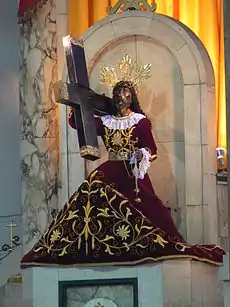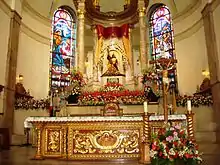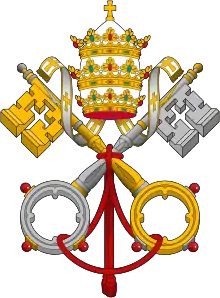Black Nazarene
The Black Nazarene (Spanish: El Nazareno Negro, Nuestro Padre Jesús Nazareno, Filipino: Poóng Itím na Nazareno, Hesus Nazareno[1]) is a life-sized image of a dark-skinned, kneeling Jesus Christ carrying the Cross enshrined in the Minor Basilica of the Black Nazarene in the Quiapo district of the City of Manila, Philippines.[2]
| Black Nazarene Nuestro Padre Jesús Nazareno Poóng Itím na Nazareno | |
|---|---|
 | |
| Location | Quiapo, Manila, Philippines |
| Date | 1606 Acapulco, Guerrero, Mexico |
| Witness | Recollect Priests Basílio Sancho de Santa Justa y Rufina, S.P., Archbishop of Manila |
| Type | Wooden statue |
| Approval | Pope Innocent X Pope Pius VII |
| Shrine | Minor Basilica of the Black Nazarene |
| Patronage | Quiapo, Manila, Filipino people, the Philippines |
| Attributes | Dark skin, maroon and gold vestments, the Cross |
The Black Nazarene was carved by an unknown Mexican from dark wood in the 16th century in Mexico and then transported to the Philippines in 1606.[2][3] It depicts Jesus en route to his crucifixion. Pope Innocent X granted recognition to the lay Confraternity of Santo Cristo Jesús Nazareno in 1650 for the promotion of the devotion to Jesus through the icon.[3] It was housed in several churches near Manila in the early decades, arriving in Quiapo Church in 1787 where it has been enshrined ever since.[3] The icon is renowned in the Philippines and is considered by many Filipino Catholics to be miraculous; its mere touch reputed to cure disease.[2][3] It attracts homage by numerous devotees and major processions every year.[3][4]
The image (in recent years a composite replica) is brought out of its shrine in procession three times a year: January 9 during the Feast of the Black Nazarene (the anniversary of the icon's translation), Good Friday (the Nazarene's liturgical feast, commemorating the culmination of the Passion), and December 31 (New Year's Eve, the first day of its annual novena).[3][5] The January 9 procession re-enacts the image's Traslación (literally "transfer") in 1787, or "solemn transfer" to the Minor Basilica from its original shrine inside Intramuros.[6][7] The January 9 Traslación is the largest procession, drawing millions of devotees thronging to touch the image and lasting 22 hours at most.[7][8][9]
The Black Nazarene is venerated by Filipino devotees every Friday. Along with the Santo Niño (Child Jesus), it is the most popular object of devotion in the Philippines.[10] A similar image called Cristo Negro is venerated in Portobelo, Panama.[11]
Terminology
The image derives its name from "Nazarene", a title of Christ identifying him as a native of Nazareth in Galilee and from its dark complexion — something uncommon amongst Philippine depictions of Jesus.
Ándas
The image's wooden base is referred to as the peana while its carriage or carroza used in processions is called the ándas (from the Spanish andar, "to move forward"). The term ándas commonly refers to the shoulder-borne palanquins of religious images and was retained for the icon's carriage which replaces the palanquins used in processions up until the late 20th century.
History

The image was made by an anonymous Mexican sculptor and arrived in Manila via galleon from Acapulco, Mexico on May 31, 1606. Traditional accounts attribute the color of the image to votive candles burning before the image, although the most widespread belief is that it was charred by fire on the galleon that brought it from Mexico.
Monsignor Sabino A. Vengco Jr. from Loyola School of Theology meanwhile noted that the image was not charred but in fact dark through to its core, as it was carved from mesquite wood. Vengco based this claim on personal research in Mexico, where he said the wood was a popular medium in the period the image was carved. He also likened it to Our Lady of Antipolo, another popular image of similar provenance and appearance.[12]
The image was first enshrined in the Church of San Juan Bautista of the Augustinian Recollects in Bagumbayan, Luneta; the area of the church first demolished in 1644 then finally destroyed during the 1762 British occupation of Manila is now part of the cascade of Padre Burgos Avenue and Maria Orosa Avenue. In 1608, the image was transferred to the Church of San Nicolás de Tolentino (popularly known as the "Recoletos Church") inside Intramuros. It was enshrined in the retablo mayor or high altar [13] of the church until both the church and the image perished in the bombardment of Manila during its liberation in 1945.
On January 9, 1787, the Augustinian Recollects donated a copy of the image to the Church of the Camisa (one of Quiapo Church's original names). This donation later on was celebrated by the faithful every January 9 by means of a procession (henceforth called the Traslación) from Intramuros (its original home, San Nicolás de Tolentino Church; later from outside Rizal Park) back to Quiapo.
A still-persistent misconception is that the icon in Quiapo Church is the original image. While the original image was always in the main altar away from the crowds, leaving only for a procession on Palm Sunday, the image enshrined in Quiapo, which has withstood four centuries of fires, earthquakes, and the Second World War, was available for physical veneration by devotees who attested to its miraculous powers.
The image presently enshrined above the main altar of Quiapo Church is a composite of the head of the Recollects' replica and the body of a replica sculpted by renowned Filipino santero (saint-maker) Gener Maglaqui, who was commissioned by the Archdiocese of Manila. The other composite comprises the body of the Recollects' replica and the head of the Maglaqui replica. Enshrined in a different part of the Basilica, it is the second composite which is used in the three major processions. This arrangement began in the 1990s because of security concerns and to better protect the icon; until then, the image donated in the 18th century was used during processions.
Description
The Black Nazarene's head wears a braided wig made of dyed abacá, along with a golden Crown of Thorns. Attached to the crown are the traditional "Tres Potencias" ("three powers") halo, symbolising the three powers of the Holy Trinity. These three rayos ("rays"), an angular variant of the cruciform halo, are exclusively used for images of Jesus Christ in traditional Filipino and Hispanic iconography to signify his divinity. The original image has lost several fingers over the centuries.
The barefoot image is shown in a genuflecting posture, symbolising the agony and the weight of the Cross, along with the overall pain Christ endured during his Passion. The Cross itself is of black wood tipped with flat, pyramidal gilt brass caps.
Vestments
The image is dressed in a heavy velvet tunic of maroon, embroidered with floral and plant emblems in gold thread, and trimmed with matching lace collar and cuffs. Around the waist is a gold-plated metal belt embossed with the word "NAZARENO", while a golden chain ending in spheres is looped around the neck and held in the left hand, representing the Scourging.
The image's vestments are changed in the Pabihis ("dressing") ritual, which is done by a priest vested in a red cope and stole, with devotees watching from either inside the Basilica or outside in Plaza Miranda. The liturgical service opens with several hymns, scriptural lessons, and prayers, and then the new vestments are blessed by the priest. A curtain is raised to cover the statue as its vestments are changed, and after some minutes the image is revealed. The old vestments are then presented to the public who queue to kiss and touch it in the belief it bears the image's miraculous properties. It is performed five times a year during preparations for major religious occasions.
Papal approval
Pope Innocent X approved veneration of the image in 1650 as a sacramental, and authorised the establishment of the Confraternity of the Most Holy Jesus Nazarene (Spanish: Cofradía de Nuestro Santo Jesús Nazareno).[14][15]
For a majority of the Spanish Era, Filipinos were barred from taking Holy Orders, while confraternities were groups of religious laymen and thus an open option. Pope Pius VII gave the image his Apostolic Blessing in 1880, which granted plenary indulgence to those who piously pray before it.
Devotions

Religious veneration of the Black Nazarene is rooted among Filipinos who identify themselves with the passion and suffering of Christ which the image depicts. Many devotees of the Black Nazarene relate their poverty and daily struggles to the Passion of Christ as represented by the image.
While the actual patron saint of the basilica is John the Baptist (making its feast day 24 June, concurrent with Manila Day), the Black Nazarene and its Traslación are more popular. At the end of each Mass offered in the Minor Basilica, devotees pay homage to the image by clapping their hands. In addition to the novena, Traslación, Pahalík, and the Pabihis, the Pasindí ("lighting") or lighting of votive candles is another popular devotion, as is the decades-old, reverential custom of creeping on one's knees up the main aisle towards the image.
The Friday of each week in the year (except Good Friday, the image's liturgical commemoration) is colloquially known in Metro Manila as "Quiapo Day", since the novena in the image's honour is held on this day nationwide. As with Wednesday (which is comparably called "Baclaran Day"), this day is associated with heavy traffic surrounding the vicinity due to the influx of devotees.
The Nazarene Catholic School (formerly known as the Quiapo Parochial School) reflects the devotion of decision-makers of the school to the Black Nazarene. The school's official newsletter is likewise named "The Nazarene" with the pupils attributed as being "Nazareñans."
The largest procession in reverence for the Black Nazarene image is the January 9 Traslación procession every year during the Feast of the Black Nazarene, attracting millions of Catholic devotees, who throng to touch or get their towel touched by the image carriers and the image and thereby get a blessing from the image.[7][8][16] Beyond the procession, every Friday, the image of the Black Nazarene is venerated by Filipino devotees. It is, along with Santo Niño (Child Jesus), is the most popular object of devotion in the Philippines.[10] In 2011, over six million Catholic devotees flocked to the Black Nazarene celebration.[17]
Hymn
The hymn Nuestro Padre Jesús Nazareno was composed by National Artist for Music Lucio San Pedro to honour the image. It is used by the Minor Basilica as the official anthem of the devotion and its associated rites.
|
|
- Waray lyrics
- Nuestro Padre Jesús Nazareno,
- Ginsisingba ka namon,
- Gindadayaw ka namon,
- Lagda mo am kinabuhi
- Ug katalwasan
- Nuestro Padre Jesús Nazareno,
- Talwasa kami sa kasal-anan
- An krus nga imo kinamatyan an
- Tigaman san amon katalwasan!
- KORO:
- || Nuestro Padre Jesús Nazareno,
- Ginpapasangyaw ka namon
- Nuestro Padre Jesús Nazareno,
- Ginhihimaya ka namon! ||
- Spanish lyrics
- Nuestro Padre Jesús Nazareno
- Te adoramos
- Te veneramos
- Tus enseñanzas son nuestra vida
- y Salvación.
- Nuestro Padre Jesús Nazareno,
- ¡Sálvanos del pecado!
- La cruz que donde has muerto es
- Señal de nuestra salvación.
- CORO:
- || Nuestro Padre Jesús Nazareno,
- ¡Te alabamos!
- Nuestro Padre Jesús Nazareno,
- ¡Te glorificamos!||
Idolatry controversy
According to Jaime Laya, the devotional worship of Black Nazarene of Quiapo is idolatry, but he states it may be a continuation of possibly pre-Christian local ritual practices.[18] Elizabeth Pisares also states that this is idolatry, and suggests its link with the social disparities among the Filipino.[19] In contrast, according to the rector Monsignor of Quiapo, Jose Clemente Ignacio, the procession and devotion is not idolatry, rather it is a reflection of "Filipino trait to want to wipe, touch, kiss, or embrace sacred objects if possible", and it is just a belief in "the presence of the Divine in sacred objects and places".[20] According to Mariano Barbato, the debate over the icon is centred on the questions of what constitutes idolatry, when an icon becomes a false god, and what makes the procession ritual idolatrous.[21]
See also
References
- Sison, Antonio D. (2015). "Afflictive Apparitions: The Folk Catholic Imaginary in Philippine Cinema". Material Religion. Routledge. 11 (4): 421–442. doi:10.1080/17432200.2015.1103474.
- John Lyden (2009). The Routledge Companion to Religion and Film. Routledge. p. 184. ISBN 978-1-135-22065-5.
- J. Gordon Melton (2011). Religious Celebrations: An Encyclopedia of Holidays, Festivals, Solemn Observances, and Spiritual Commemorations. ABC-CLIO. pp. 118–119. ISBN 978-1-59884-206-7.
- John N. Schumacher (1968), The Depth of Christianization in Early Seventeenth-Century Philippines, Philippine Studies, Vol. 16, No. 3 (JULY 1968), pages 535-539
- John Lyden (2009). The Routledge Companion to Religion and Film. Routledge. pp. 184–185. ISBN 978-1-135-22065-5.
- Jean-Guy A. Goulet; Liam D. Murphy; Anastasia Panagakos (2015). Religious Diversity Today: Experiencing Religion in the Contemporary World. ABC-CLIO. pp. 147–152. ISBN 978-1-4408-3332-8.
- Tony Twigg (2015), THE BLACK NAZARENE, A PHILIPPINE NATIONAL ETHO, TAASA Review, Volume 24, Number 2 (June 2015), pages 16-18
- Paul-François Tremlett (2008). Religion and the Discourse on Modernity. Bloomsbury Academic. pp. 1–5, 121–122. ISBN 978-0-8264-9823-6.
- Joi Barrios (2015). Intermediate Tagalog. Singapore: Tuttle. pp. 182–183. ISBN 978-1-4629-1427-2.
- Geoffrey Wainwright (2006). The Oxford History of Christian Worship. Oxford University Press. p. 674. ISBN 978-0-19-513886-3.
- J. Gordon Melton (2011). Religious Celebrations: An Encyclopedia of Holidays, Festivals, Solemn Observances, and Spiritual Commemorations. ABC-CLIO. pp. 116–119. ISBN 978-1-59884-206-7.
- De Guzman, Odi (January 8, 2015). "Black or white: The Nazarene and the Pinoy devotion". GMA News Online. Retrieved January 10, 2015.
- https://www.flickr.com/photos/johntewell/25776962904/ Inside view of Recoletos Church, Intramuros, Manila, Philippines, 1905 by John Tewell]
- Michael M. Ramos (2015), POPULAR RELIGIOSITY: A FILIPINO EXPERIENCE OF AN INCULTURATED FAITH, Canadian International Journal of Social Science and Education, Volume 7, page 246; Quote: "This confraternity of the Nazarene was officially authorized by the bull of Pope Innocent X expedited in Rome on April 20, 1650, "By which the confraternity of N.P. Jesus Nazareno was erected and founded in the Church of the Agustinos Recoletos Descalzos in the city of Manila, and by virtue of which many graces and indulgences were granted to the members".
- Leonardo Mercado (2002). Jesus Christ and the Gentile Mission. Gregorian Biblical BookShop. pp. 320–321. ISBN 978-88-7652-944-3.
- Joi Barrios (2015). Intermediate Tagalog. Singapore: Tuttle. pp. 182–184. ISBN 978-1-4629-1427-2.
- Jose Alain Austria (2012), Hijos de Enero 9: Quiapo's Black Nazarene Procession as a Male Rite of Passage, Manila Journal, Volume 8, Number 1, page 15; Quote: "This year [2011] approximately 6.5 million devotees flocked to Quiapo and the Luneta, joining the longest procession on record of sixteen hours. (...) What seems to be pure mayhem in the eyes of the on-looker, or pure faith on the part of the religious, is also a complex of herculean tasks that the young male devotee must perform not only to gain graces, but also to earn the approval of both his peers, the elder male devotees, and most importantly the Nuestro Padre Jesus Nazareno.".
- Jaime C. Laya (2001). Letras Y Figuras. Manila: Anvil. pp. 89–90. ISBN 978-971-27-1143-5.
- Elizabeth H. Pisares (1999). Daly City is My Nation: Race, Imperialism and the Claiming of Pinay / Pinoy Identities in Filipino American Culture. University of California Press. p. 58. OCLC 43832108.
- Jazmin Badong Llana (2014), Inaesthetics of Performance in the Black Nazarene Procession, De La Salle University, DLSU Research Congress 2014, page 3
- Barbato, Mariano (2013). "Self: Pilgrim, Nomad, Homo Faber". Pilgrimage, Politics, and International Relations. pp. 55–82. doi:10.1057/9781137275813_3. ISBN 978-1-137-27581-3.
External links
| Wikimedia Commons has media related to Black Nazarene. |
- Quiapo Church Website Minor Basilica of the Black Nazarene – Parish of Saint John the Baptist • Quiapo • Manila
- GMA NEWS.TV, Emergency: Pista ng Nazareno - 01/12/2008
- GMA NEWS.TV, Gma News Research, The Black Nazarene
- Pinoys celebrate 405th anniversary of the Black Nazarene 2012
- Inquirer News | Philippine Catholic pilgrims defy terror alert
- Manila Bulletin | Devotees defy threat

